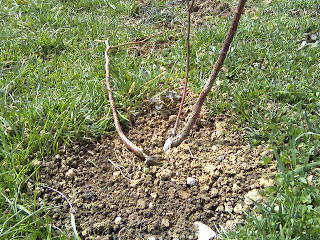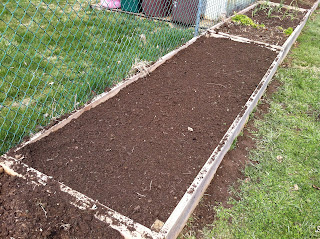I have been inspired this year by a video that I saw called
"Back to Eden" which you can watch
here on Vimeo.
God is the great orchestrator of all on earth. And when we (people) try to take over, we mess things up. What I have gotten out of this video is that if we just pause for a moment and take a look around, we can see all of the answers to our questions by looking at God's amazing creation.
So, what does that mean for gardening? Well...if you look out in nature, you can see that God gives us all we need to grow crops, and grow crops well. It's when we try to over-engineer things that we make more work for ourselves. Tilling, weeding, pest control to name a few.
Additionally, over the years, we have become more accustomed to all things prepared, refined and boxed. Our taste buds know little anymore of whole, raw, organic, fresh food. We find something like a donut to be called a sweet treat, when an apple is what a sweet treat means. Sweet doesn't have to be bad for you, God didn't make it that way. He gave us taste buds to enjoy food. Indulge yourselves without guilt with a bushel of fresh strawberries, for example. Satisfy your crunchy craving on fresh baby spinach and baby carrots. Nibble on sprouted lentils It's all there for the taking.
So, what does this mean for me this growing season? Well, I am going to be adopting the principles from
Paul Gautschi by focusing on a ground covering for my garden. I've been using raised beds for years and have been pleased with the success from them. Beds that are not walked on and I am constantly enriching with compost. I started falling back onto my old habits of tilling, which is really contradictory to God's plan. Tilling is really more harm than good. It breaks up all the good soil and worms that are busy keeping my raised beds soft and fluffy. That plus, without fail, a week after I till, I am out there weeding. One other issue I have throughout the season is watering. What a chore it is to make sure each day that my garden is watered. And if I miss a few days, the crops are stressed.
So my plan this year is to get a good covering on my garden which will keep weeds down, and the earth below constantly moist. According to Paul, and also
Ruth Stout with a covering, one does not have to worry about watering. The covering keeps just the right amount of moisture in the garden during periods of drought as well as rains. The covering continues to break down providing the nutrients that are needed to keep the soil enriched and soft.
What I have done the past weeks is get a good 3" covering on my raised beds. I have about 200 sq ft of raised beds. I called our township borough to make sure it was ok to get some wood chippings from their compost facility. They were happy to ablige. So over the past weeks, Mike and I have filled garbage bags with wood chippings and leaves and brought them to my garden. The picture in this blogs illustrates what this looks like. I also have my compost bin constantly at work. One thing that my compost bin lacks is browns (the nitrogen) as we have no trees on our property or on our street for that matter. When Mike and I were pitching leaves from the compost facility into garbage bags in the dead of winter, I was amazing to see a warm steam coming from the composting leaves. The leaves were even hot to the touch! How cool is that?! God at work even in the coldest of days.
 |
| Birds eye view of my garden |
 |
| tree chippings |
 |
| more tree chippings, garlic is under there waiting for the warm weather! |
There is never a wrong time to get your garden started with a good covering. I will be blogging about my experience of my Back to Eden garden this season.
This weekend I started some early seeds. Onions, (yellow and scallions), broccoli, broccoli rabe, celery and parsley.
 |
| Onions, broccoli, broccoli raab, celery, parsley started |
Next weekend peppers and radicchio will be started. My goal this year is to see if I can grow, all that I enjoy eating. Years past I've focused on large quantities of the easy stuff. This season it will be more of manageable portions of we eat on a regular basis. Some newer endevours for me are radicchio, kale, brussel sprouts, chinese cabbage, dried beans, parsnips and winter squashes. Biting off more than I can chew? Perhaps, but with all failures, come growth and learning.






































